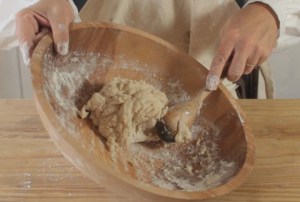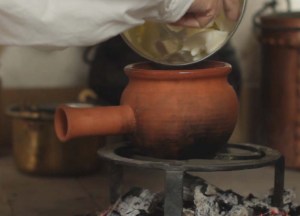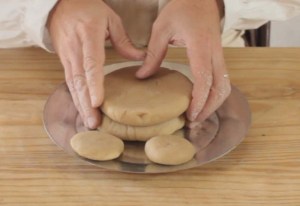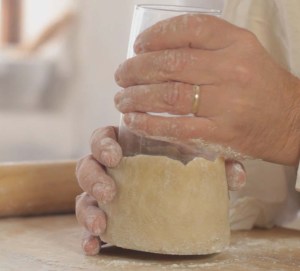The standing crust was probably the oldest form of pastry in English cooking. While it really wasn’t intended to be consumed, it was an ingenious culinary invention designed to serve as a baking dish, a storage dish, and a serving dish. To read more on the standing crust, refer to our post, “The Crust of Time.”
Here is a recipe for a standing crust, adapted from a number of 18th century recipes. It’s proportions are suitable for two individual-serving standing crusts. A demonstration of how to make this crust can be seen in the video below. At the end of this post, we’ve also included a recipe for pork pies from Maria Rundell’s 1807 book cookbook, “A New System of Domestic Cookery.”
A Recipe for a Standing Paste
Ingredients:
- 2-1/2 cups All-Purpose Flour
- 6 Tablespoons Butter, Lard, or a combination of both
- 1/2 cup plus 2 Tablespoons Water
- 1/2 teaspoon Salt
- 1 Egg, beaten, for egg wash
Directions:
Bring the water, salt, and lard or butter to a boil and then add the mixture to the flour. Bring the dough together and knead for about 10 minutes. The texture will resemble that of “Play-Doh.”

Divide your dough into 2 equal portions, then remove a lump from each portion, about the size of a walnut (for the lids).
Roll your dough portions into balls and flatten into disks about 1″
thick, then wrap them in a damp cloth or plastic wrap, and allow to
cool and rest for at least 3 – 4 hours or even overnight.
When forming the crust, begin by dredging each portion of dough
in flour. Roll out the 2 smaller pieces to about 1/8″ thick. These
are your lids.
Take a bottle, jar, or drinking glass about 2-1/2″ to 3″ in diameter and place it in the middle of each of the larger dough disks and press down. Be careful to avoid pressing all the way through the dough. The bottom should be no less than 1/8″ thick. We are uncertain what tool was used in the 18th century to do this step. Cooks in modern Melton-Mowbray use a wooden mallet-like tool to form the crust, but while we know the crust itself is a carry-over from the 18th century, we don’t know if the tool is as well. Larger standing crusts were sometimes constructed in pieces. We will demonstrate that technique in a subsequent post.
With the palms of your hands, squeeze and pull the dough up the sides of the form, rotating the form and pressing the dough as you work. The walls should be about 2-1/2″ to 3″ tall, and 1/4″ thick.
Gently remove your form. Adjust the wall thickness by gently squeezing the dough. Any cracks in the dough can be repaired by brushing a little water in between the two halves of the crack and squeezing them together.
“An Excellent Pork Pie, to Eat Cold” adapted from Maria Rundell’s book, “A New System of Domestic Cookery” (1804)
Ingredients:
- 1 lb. Pork Shoulder, pounded thin and coarsely chopped
- 2 Tablespoons Fine Bread Crumbs (optional)
- 1/2 teaspoon each, Salt and Pepper
- 1 T. Butter
- 1 egg, beaten for egg wash
- 1 Pig’s foot (or 1 package of unflavored gelatin)
Directions:
Combine the pork, bread crumbs, salt, and pepper. Divide the pork mixture evenly, and gently press into each standing crust, eliminating any possible trapped air. Top with a dab of butter.
Brush egg wash on the inside of the standing crust’s rim, and place the lid over the pork. Seal the crust by crimping the lid to the walls.
Poke or cut a vent hole into each lid. Brush the lid with egg wash, avoiding the crimped edges lest they burn. Bake in a medium oven, 350° (F), for 1 hour. Allow to cool.
While the pies are cooling, cover the pig’s foot with water and boil for one hour. Strain off the broth and pour into the vent hole of each pie. This broth is called a “lear.” While the use of a lear is not found in Rundell’s recipe, they were often used with standing-crust dishes, and are still used today in the traditional British pork pie.
Allow to cool completely before serving.









Thanks for yet another great recipe. The remark about it likely not being eaten is interesting indeed.
Pingback: A Short Paste, a Delicious Pear Tart, and a Choice of Three Toppings | Savoring the Past
Pingback: The Christmas Pie | Savoring the Past
Pingback: A Pork Pie with a Standing Crust | Savoring the Past
We always look forward to each new recipe and episode! Thank you!
Pingback: The Crust of Time | Savoring the Past
Pingback: A Large Standing Crust | Savoring the Past